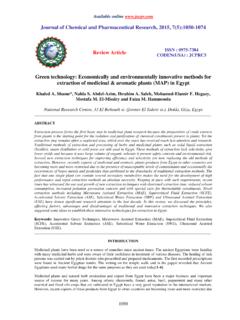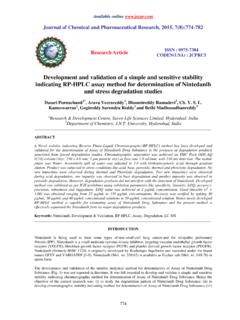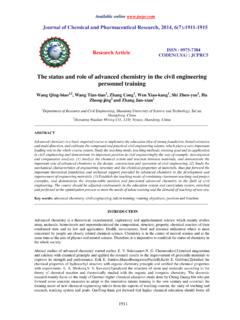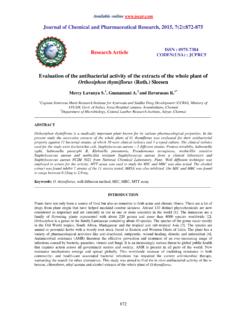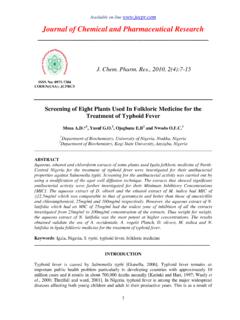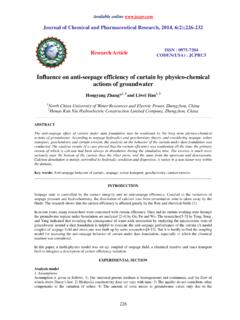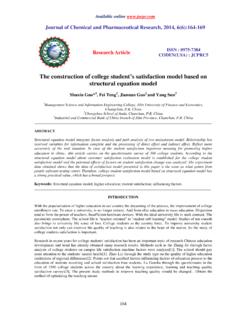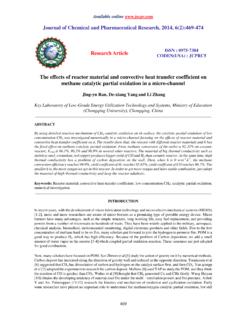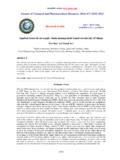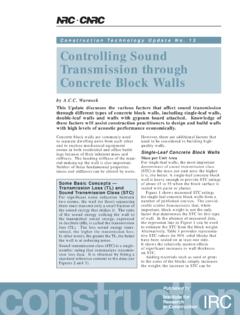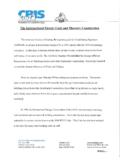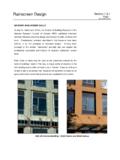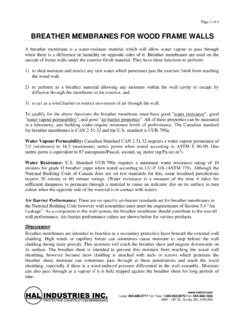Transcription of Design on ECM Device for Chamber Body Cavity of Gun Barrel
1 Available online Journal of Chemical and Pharmaceutical Research, 2014, 6(6):2805-2815 Research Article ISSN : 0975-7384 CODEN(USA) : JCPRC5 2805 Design on ECM Device for Chamber body Cavity of Gun Barrel Jianli Jia1, Jinhe Liu1 and Xi Wang2 1 School of Materials and Engineering, Northwestern Polytechnical University, Xi'an, PR China 2 School of Mechatronic Engineering, Xi'an Technological University, Xi'an, PR China _____ ABSTRACT Electrochemical machining (ECM) is a method based on electrochemical process for removing metals in mass productions. In weapons industry, the project of ECM of Chamber body Cavity was put forward for its high precision and no cutting stress. According to research object Chamber body Cavity , ECM Device was designed, which were the inner Cavity of ECM. Thereinto, with the use of the parallel gap method, the polishing cathode and the processing cathode of the complex inner Cavity were designed; in consideration of the Design of the two sets of fixture were done for the external shape of Chamber body , and the base of the fixture should be equipped with a conductive seat; in addition, what needed to be considered were the relative problems of the electricity conduction, the feed liquid, the flow distribution and the insulation sealing between work pieces and fixtures.
2 Among them, the method of the feed liquid lies in side streaming; the conductive method was to transmit the electric current to the workpiece through the galvanical fixture, and the conduction of cathode was through the draw bar which connected to the spindle. Under the fixture seat, an insulating board was added to bring about the insulation effect. The way to prevent the electrolyte from overflowing is to fill the gap between the draw bar and the end face of the fixture with a sealing gasket. Experimental results indicate that Chamber body Cavity can be produced at one time with good quality and high efficiency. Key words: Chamber body Cavity , Device , Gun Barrel , ECM, Cathode. _____ INTRODUCTION Electrochemical machining (ECM) is an advanced machining technology. ECM has seen a resurgence of industrial interest within the last couple of decades due to its many advantages such as no tool wear, stress free and smooth surfaces of machined product and ability to machine complex shape in electrically conductive materials, regardless of their hardness [1]~[3].
3 It has been applied in highly specialized fields such as aerospace, aeronautics, and medical industries. ECM is one of advanced machining technologies. Gussef originally proposed and designed the ECM procedure in 1929 [4]~[5]. Since then, ECM has been developed and employed in highly specialized fields such as aerospace, aeronautics, defense, and medicine[6]~[8]. It is a non-traditional machining (NTM) process and is opposite of galvanic coating or deposition process. Thus ECM can be thought of a controlled anodic dissolution at atomic level of the work piece that is electrically conductive through an electrolyte which is quite often water based neutral salt solution[9]~[11]. Because of various complex physic-chemical and hydrodynamic phenomena that occur in the machining gap during the course of machining, the machining rate at any instant depends not only on the end gap, but also on cathode and ECM Device [12].
4 Thin deep hole are among the most innovative and challenging components in modern artillery, deep spline and Chamber body Cavity . They could reduce weight obviously and significantly improve efficiency and reduce fuel consumption [13]. Chamber body Cavity of gun barrels is usually made of Special Purpose steel or Ni-base superalloys which are extremely difficult to be machined. Moreover the shapes of these Chamber body Cavity profiles are very complex, so it is very difficult to achieve the required component by traditional methods such as Jianli Jia et al J. Chem. Pharm. Res., 2014, 6(6):2805-2815 _____ 2806 cutting processes [14]~[16]. The ECM method is quite effective and accurate to obtain a required shape of work-piece within a given tolerance on the shape and dimensions using the cathode-tool electrode with a shape which is geometrically close to the final shape of the workpiece [17].
5 This paper aims to present a high efficiency ECM method and Device of Chamber body Cavity in which cooper as cathode tools move towards workpiece parts with appropriate feed rate and the electrolyte is ejected from the outlets of the preformed hole walls to the workpiece to electrochemically produce three Chamber body Cavity simultaneously. The shape and structures of electrolyte outlets on the preformed hole wall are also optimized for distributing the electrolyte flow more uniformly. Experimental results indicate that Chamber body Cavity can be produced at one time with good quality and high efficiency by applying designed ECM Device in this investigation. EXPERIMENTAL SECTION THE PRINCIPLE AND EXPERIMENTAL SYSTEM OF ECM ECM process is quite similar in concept to electrical discharge machining with a high current passed across its inter-electrode gap through the electrolyte, a material removal process having a negatively charged electrode (tool cathode), conductive fluid (electrolyte), and a conductive workpiece (anode), however in ECM there is no tool wear [18].
6 The ECM cutting tool is guided along the desired path very close to the work but it does not touch the piece. Unlike EDM however, no sparks are created. ECM is an electrochemical process in which the work piece acts as an Anode and the tool acts as a Cathode [19]~[20]. An electrolyte generally sodium chloride or sodium nitrate with a velocity of 5~50 m/s is supplied through the concentric hole in the cathode and it falls over the anode surface, a small gap of ~1mm is provided in between the two electrodes. When a small voltage of 5~30V is applied across the inter electrode gap, a high current density of the order of 5~100A/cm2 is producing which results in dissolution of metal from workpiece as anode electrochemically and gas generation occurs at tool cathode. ECM is the controlled removal of metal by anodic dissolution in an electrolytic cell in which the work piece is the anode and the tool is cathode.
7 ECM is developed on the principle of Faradays and Ohm [21]. In this process, an electrolyte cell is formed by the anode (workpiece) and the cathode (tool) in the midst of a following electrolyte (as ). The metal is removed by the controlled dissolution of the anode according to the well-known Faradays law of electrolysis. Figure 1 shows two electrodes which are placed closely with a gap of about and immersed in an electrolyte which is a solution of sodium chloride (common salt). The high current densities promote rapid generation of metal hydroxides and gas bubble in the small spacing between the electrodes. These become a barrier to the electrolyzing current after a few seconds. To maintain a continuous high density current, these products of machining must be continuously removed. This is achieved by circulating the electrolyte at a high velocity through the gap between the electrodes.
8 It is also to be noted that the machining gap size increases as the metal is removed. The larger gap leads to a decrease in the metal removal rate. Therefore to maintain a constant gap between the tool and workpiece, the cathode (tool) should be advanced towards the anode (workpiece) at the same rate at which the metal is removed. ECM removes material from the work piece by electrochemical process. The working principle is anodic dissolution in which the workpiece as anode and the tool as cathode. Both electrodes are immersed in the electrolyte and electrical applied to these electrodes. The electric conduction is achieved through the movements of ions between the anode and cathode through the electrolyte. The current is passing through the system of arrangements will cause the dissolution of anode. This process of electrolysis is working based on Faradays law of electrolysis. The principal and experimental system detailing of ECM for steel is shown in , generally a neutral salt solution of sodium chloride (NaNO3+NaClO3) is taken as the electrolyte.
9 The setup consists of three major sub-systems: Machining cell, Power supply, Electrolyte circulation. Jianli Jia et al J. Chem. Pharm. Res., 2014, 6(6):2805-2815 _____ 2807 : Experimental system of ECM Machining cell The electro-mechanical assembly is a sturdy structure, associated with precision machined components, servo motorized vertical up/down movement of tool, an electrolyte dispensing arrangement. All the exposed components and parts have undergone proper material selection and coating/plating for corrosion protection. Tool area- 6800 mm2 Cross head stroke 8000 mm Tool feed motor DC servo type Power supply The power supply by Pulses current power is a perfect integration of high current electrical, power electronics and precision programmable micro-controller-based technologies. Since the machine operates at very low voltage and high current, there are no chances of any electrical shocks during operation.
10 Electrical output rating 0~8000A. DC at any voltage from 0~30 V Tool feed rate to 50 mm/min Supply 415 v 10%, three-phase AC, 50 Hz Frequency is 1~10 kHz, duty ratio is ~ Electrolyte circulation Allowing the electrolyte to flow through the inter-electrode gap to remove the solid and gaseous products as well as the heat generated caused by the passes of current and electrochemical reactions. The rates of electrochemical dissolution depend strongly on the temperature. The energy losses in the gap are large but the heat can be removed by high flow of electrolyte and, thus, depends on the geometry. Accordingly the temperature at the anode surface is not exactly known, it can be in the range from 40 to 85 . The electrolyte is pumped from a tank, lined by corrosion resistant coating with the help of corrosion resistant pump and is feed to the job. The reservoir provides separate settling and siphoning compartments.
